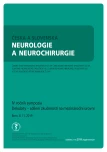Pain assessment of surgical wounds after angio-surgical interventions
Authors:
P. Juřeníková 1; T. Novotný 2; R. Staffa 2; M. Krejčí 2
Authors‘ workplace:
Katedra ošetřovatelství a porodní asistence, LF MU, Brno
1; II. chirurgická klinika, Centrum cévních onemocnění, LF MU a FN u sv. Anny v Brně
2
Published in:
Cesk Slov Neurol N 2019; 82(Supplementum 1): 44-46
Category:
Original Paper
doi:
https://doi.org/10.14735/amcsnn2019S44
Overview
Aim: The aim of the prospective study was to analyze the intensity of pain after surgery, perception of discomfort and post-operative pain, and the overall life feelings related to the intervention treatment.
Patients and methods: The sample comprised 76 patients who had been admitted and underwent a vascular surgical procedure of an abdominal aortic aneurysm / iliac aneurysm (21.05%), femoral/ popliteal aneurysm (23.68%), aortoiliac occlusive disease (3.95%), and infrainguinal occlusive disease (51.32%). The patients evaluated the pain intensity, discomfort of the pain, and the overall life feelings on a Visual Analogue Scale. The scale assessment was tested on 0– 7th day post-operatively through the Fisher‘s exact test, the chi-squared test was used for the gender, age, diagnosis, surgery type, anesthesiology risk, comorbidity, and complications related to the surgical intervention. A 5% level of significance was used for the testing.
Results: When assessing the pain intensity, discomfort of pain, and the perception of overall life feelings, there was find a significant difference in relation with the type of the surgical intervention, diagnosis.
Conclusion: Pain management is an important part of post-operative care. A systematic pain assessment is necessary to manage the pain appropriately. The highest intensity of pain was measured in patients after redo surgery, the worst discomfort and overall feeling were recorded in patients after abdominal aortic/pelvic artery aneurysm resection, while the highest intensity of pain and the worst overall feeling were measured in the first postoperative days with decreasing tendency over the time.
Keywords:
vascular surgical procedure – pain assessment – post-operative pain – surgical wound
Sources
1. Juřeníková P, Novotný T, Staffa R et al. Vybraná perioperační problematika cévněchirurgických pacientů. 1. vyd. Brno: Masarykova univerzita 2018.
2. Gan TJ, Habib TE, Miller W et al. Apfelbaum incidence, patient satisfaction, and perceptions of post-surgical pain: results from a US national survey. Curr Med Res Opin 2014; 30(1): 149– 160. doi: 10.1185/ 03007995.2013.860019.
3. Gerbershagen HJ, Aduckathil S, van Wijck AJ et al. Meissner pain intensity on the first day after surgery: a prospective cohort study comparing 179 surgical procedures. Anesthesiology 2013; 118(4): 934– 944. doi: 10.1097/ ALN.0b013e31828866b3.
4. Castle NG, Engberg J. Further examination of the influence of caregiver staffing levels on nursing home quality. Gerontologist 2008; 48(4): 464– 476. doi: 10.1093/ geront/ 48.4.464.
5. Chapman RC, Donaldson WG, Davis JJ et al. Improving individual measurement of postoperative pain: the pain trajectory. J Pain 2011; 12(2): 257– 262. doi: 10.1016/ j.jpain.2010.08.005.
6. Huskisson EC. Measurement of pain. Lancet 1974; 2: 1127– 1131. doi: 10.1016/ s0140-6736(74)90884-8.
7. Price DD, Harkins SW. The affective-motivational dimension of pain: a two stage model. Am Pain Soc J 1992; 1: 229– 239.
8. Childs JD, Piva SR, Fritz JM. Responsiveness of the numeric pain rating scale in patients with low back pain. Spine (Phila Pa 1976) 2005; 30(11): 1331– 1334.
9. Knotek P, Šolcová I, Žalský M. Česká verze krátké formy Dotazníku bolesti McGillovy Univerzity: restandardizace. Bolest 2002; 5(3): 169– 172.
10. Hlinková1 E, Nemcová J, Simová A et al. The factors of pressure ulcer’s healing in critically ill patients. Cesk Slov Neurol N 2018; 81/ 114 (Suppl 1): S13– S18. doi: 10.14735/ amcsnn2018S13.
11. Glaser R, Kiecolt-Glaser JK, Marucha PT et al. Stress--related changes in proinflammatory cytokine production in wounds. Arch Gen Psychiatry 1999, 56(5): 450– 456.
12. Kiecolt-Glaser JK, Marucha PT, Malarkey WB et al. Slowing of wound healing by psychological stress. Lancet 1995; 346(8984): 1194– 1196. doi: 10.1016/ s0140-6736(95)92899-5.
13. Marucha PT, Kiecolt-Glaser JK, Favagehi M. Mucosal wound healing is impaired by examination stress. Psychosom Med 1998; 60(3): 362– 365.
14. Padgett DA, Marucha PT, Sheridan JF. Restraint stress slows cutaneous wound healing in mice. BrainBehav Immun 1998; 12(1): 64– 73. doi: 10.1006/ brbi.1997.0512.
15. Page GG, Ben-Eliyahu S. The immune-suppressive nature of pain. Semin Oncol Nurs 1997; 13(1): 10– 15.
16. McGuire L, Heffner K, Glaser R et al. Pain and wound healing in surgical patients. Ann Behav Med 2006; 31(2): 165– 172. doi: 10.1207/ s15324796abm3102_8.
17. Taylor A, Stanbury L. A review of postoperative pain management and the challenges. Curr Anaesth Crit Care 2009; 20(4): 188– 194. doi: 10.1016/ j.cacc.2009.02.003.
18. van Dijk, WJ, Vervoort SC, van Wijck AJ et al. Postoperative patients’ perspectives on rating pain: a qualitative study. J Nurs Stud 2016; 53: 260– 269. doi: 10.1016/ j.ijnurstu.2015.08.007.
19. Meissner W, Coluzzi F, Fletcher D et al. Improving the management of post-operative acute pain: priorities for change. Curr Med Res Opin 2015; 31(11): 2131– 2143. doi: 10.1185/ 03007995.2015.1092122.
20. Ahlers SJ, van Gulik L, van der Veen AM et al. Comparison of different pain scoring systems in critically ill patients in a general ICU. Crit Care 2008; 12(1): R15. doi: 10.1186/ cc6789.
Labels
Paediatric neurology Neurosurgery NeurologyArticle was published in
Czech and Slovak Neurology and Neurosurgery

2019 Issue Supplementum 1
Most read in this issue
- Quality of life in patient with non-healing wounds
- The knowledge and practises of nurses in the prevention of medical devices related injuries in intensive care – questionnaire survey
- The use of negative pressure wound therapy for wound complication management after vascular procedures
- Negative wound pressure therapy in treatment of a pressure ulcer in paraplegics
